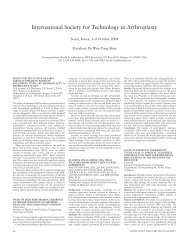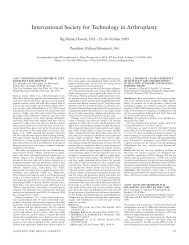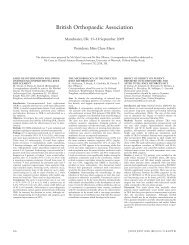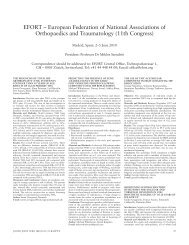Procs III 2011.indb - Journal of Bone & Joint Surgery, British Volume ...
Procs III 2011.indb - Journal of Bone & Joint Surgery, British Volume ...
Procs III 2011.indb - Journal of Bone & Joint Surgery, British Volume ...
You also want an ePaper? Increase the reach of your titles
YUMPU automatically turns print PDFs into web optimized ePapers that Google loves.
348 HELLENIC ASSOCIATION OF ORTHOPAEDIC SURGERY AND TRAUMATOLOGY<br />
signifi cantly improved their range <strong>of</strong> joint movement<br />
and were relieved from pain. Surgical excision seems to<br />
provide a superior quality <strong>of</strong> life in these patients, as<br />
they have a high risk for major complications due to<br />
their poor level <strong>of</strong> mobility.<br />
054 THE 22-TO 34YEARS OUTCOME<br />
OF CHARNLEY LOW FRICTION<br />
ARTHROPLASTY IN YOUNG PATIENTS<br />
WITH OSTEOARTHRITIS<br />
G. Georgiades, G. Babis, G. Kourlaba, G.<br />
Hart<strong>of</strong>ilakidis<br />
1st Department <strong>of</strong> Orthopaedics, University <strong>of</strong><br />
Athens Medical School<br />
We reported on the outcome <strong>of</strong> 84 Charnley low friction<br />
arthroplasties performed by one <strong>of</strong> us (GH), the<br />
period 1973 to1984, in 69 patients, less than fi fty-fi ve<br />
years old, with osteoarthritis mainly due to congenital<br />
hip disease.<br />
The patients were followed prospectively; clinically<br />
using the Merle D’Aubigné and Postel scoring system, as<br />
modifi ed by Charnley and also radiographically.<br />
At the time <strong>of</strong> the latest follow-up, thirty-seven hips<br />
had failed (44%). In thirty-two hips, twenty-eight acetabular<br />
and thirty femoral components were revised<br />
because <strong>of</strong> aseptic loosening (six <strong>of</strong> the femoral components<br />
were broken). Three hips were infected and<br />
converted to resection arthroplasty. In two more hips<br />
a periprosthetic femur fracture occurred three and ten<br />
years postoperatively and were treated with internal<br />
fi xation. After a minimum <strong>of</strong> twenty-two years from<br />
the index operation, 37 original acetabular components<br />
and 36 original femoral components were in place for<br />
an average <strong>of</strong> 29 years. The probability <strong>of</strong> survival for<br />
both components with failure for any reason as the end<br />
point was 0.51 (95% confi dence interval, 0.39 to 0.62)<br />
at twenty-fi ve years when 35 hips were at risk.<br />
These long term results can be used as a benchmark <strong>of</strong><br />
endurance <strong>of</strong> current total hip arthroplasties performed<br />
in young patients, with OA mainly due to congenital<br />
hip disease.<br />
055 HYBRID STEM FIXATION IN REVISION<br />
HIP ARTHROPLASTY<br />
A. Tsamatropoulos, C.Vassos, E. Karavas, G.<br />
Epaggelis, D. Chalatsis, K. Sarafis<br />
1st Orthopaedic Department, General Hospital <strong>of</strong><br />
Asclepeion Voulas<br />
This study reports the results <strong>of</strong> hybrid stem fi xation<br />
in diffi cult revision hip arthroplasties where proximal<br />
femoral bone stock loss was severe.<br />
Twenty-six revision arthroplasties (21 women and<br />
5 men, aged from 58 to 86 years), were performed<br />
between 1998 and 2008. The indication for surgery was<br />
aseptic loosening. In all cases, stabilization <strong>of</strong> the stem<br />
presented problems because <strong>of</strong> severe proximal femoral<br />
bone stock loss (due to extensive periprosthetic osteolytic<br />
defects), or because <strong>of</strong> iatrogenic defects or surgical<br />
procedures (attempts to remove the stem and cement<br />
with fenestration or extended osteotomy). The average<br />
follow-up was 48 months (range 16 to 120).<br />
Primary stability is necessary for the successful defi -<br />
nite fi xation <strong>of</strong> a cementless implant by bone. When this<br />
was not possible (because <strong>of</strong> proximal cortical insuffi -<br />
ciency), we used a modular distally cemented long stem,<br />
bypassing the area <strong>of</strong> bone defect for at least 6-7 cm.<br />
Proximally bone defects were grafted and osteotomy<br />
was closed with cerclage wires.<br />
Four stems (15%) had an asymptomatic subsidence<br />
(3 stems subsided less than 3-4 mm and 1 stem about<br />
15mm). No stem was revised to date. Major complications<br />
did not occur. The mean Harris hip score improved<br />
from 32 points preoperatively to 82.3 points (at the<br />
most recent evaluation).<br />
Hybrid fi xation <strong>of</strong>fers the advantage <strong>of</strong> initial and<br />
secure stability <strong>of</strong> the cemented stem on the short term,<br />
until stabilization <strong>of</strong> the entire implant by bone occurs.<br />
Thus early subsidence and loosening is avoided and on<br />
the long term benefi ts <strong>of</strong> the cementless fi xation are<br />
attained. Our results support the method <strong>of</strong> hybrid<br />
fi xation in patients with severe femoral bone loss (and<br />
consequently problematic stabilization), when primary<br />
stability is needed.<br />
056 TOTAL HIP REPLACEMENT IN PATIENTS<br />
WITH FEMORAL DYSPLASIA USING<br />
STRAIGTH CONICAL WAGNER-TYPE STEMS<br />
R.A. Giannakos, K. Bargiotas, L. Papatheodorou,<br />
S. Varitimidis, T. Karachalios, K.N. Malizos<br />
University <strong>of</strong> Thessalia, Department <strong>of</strong><br />
Orthopaedics<br />
The evaluation <strong>of</strong> the middle term behaviour <strong>of</strong> the<br />
Wagner-type stems in dysplastic femurs and the presentation<br />
<strong>of</strong> the technical and surgical differences with the<br />
implantation <strong>of</strong> a Wagner stem.<br />
Between 1997 and 2008 we implanted 64 Wagner<br />
stems in 58 patients. Average age at the time <strong>of</strong> implantation<br />
was 64 years. 52 patients was operated because<br />
<strong>of</strong> DDH, and 12 had had previous osteotomy. All<br />
patients were prospectively evaluated radiographically<br />
and clinically at annual intervals. Functional outcome<br />
was assessed with Harris Hip Score and Oxford Score.<br />
Mean follow-up <strong>of</strong> these series was 4 years (11-1)One<br />
stem was revised because <strong>of</strong> fracture <strong>of</strong> the lesser trochander<br />
and two more patients were re-operated for<br />
open reduction. With the re-operation as end-point<br />
and 95% Confi dence Interval survivorship rate was 98,<br />
5%. There were no progressive radiolucent lines. Stem<br />
migration was at an average 2mm (1-6) during the fi rst<br />
two years and remained stable thereafter.There was no<br />
deep infection in these series. After the second year a<br />
dense zone is evident in all Gruen zones at the implant<br />
–bone interface with a width <strong>of</strong> 2-3 mm.<br />
Dysplasia <strong>of</strong> the proximal femur may pose signifi cant<br />
technical problems during THA due to the distortion <strong>of</strong><br />
the geometry and the narrowing <strong>of</strong> the femoral canal.<br />
The sort, conical Wagner type stems can <strong>of</strong>fer a very<br />
good alternative is such patients. They allow control <strong>of</strong><br />
the anteversion and they are able get a good press-fi t<br />
despite the metaphyseal/diaphyseal mismatch and the<br />
femoral bowing.<br />
Wagner type stems are a reliable alternative when<br />
performing THA in patients with dysplastic femurs.<br />
057 THE USE OF A CALCIUM<br />
HYDROXYAPATITE ANTIBIOTIC CARRIER<br />
(PEROSSAL*) AS A SPACER IN TWO-STAGE<br />
REVISION INFECTED ARTHROPLASTY<br />
A. Drakou, G. I. Karaliotas, V. Sakellariou, H.<br />
Tsibidakis, P. Pantos, A. Papadopoulos<br />
1st Department <strong>of</strong> Orthopaedics, Athens<br />
University Medical School, ATTIKON University<br />
Hospital, Athens, Greece, 4th Department <strong>of</strong><br />
Internal Medicine, Athens University Medical<br />
School, ATTIKON University Hospital, Athens,<br />
Greece<br />
Two-stage revision procedure is the gold standard in<br />
management <strong>of</strong> periprosthetic infections. Cement spacers<br />
have long been used to preserve the space created<br />
during resection procedure and to release antiobiotics<br />
within the created dead space. However, the problems<br />
related to cement as an antibiotic carrier are well recognised<br />
(thermal necrosis, random porosity, unspecifi ed<br />
antibiotic delivery rate).<br />
To present the concept <strong>of</strong> using PerOssal as a canal<br />
fi lling spacer and local antibiotic delivery system in twostage<br />
revisions <strong>of</strong> hip and knee infected arthroplasty.<br />
8 patients (6 females, 2 males) with infected arthroplasty<br />
(4 TKRs, 4 THRs) were managed with two-stage<br />
revision procedures during the years 2006-2008 (minimum<br />
FU: 12 months). Our protocol consisted <strong>of</strong>: a)<br />
Preoperative determination <strong>of</strong> the causative organism<br />
b) Radical debridement surgery and cement spacer with<br />
PerOssal implantation c) Appropriate IV antibiotic therapy<br />
for 6 weeks, postoperative clinical evaluation and<br />
monitoring <strong>of</strong> infl ammation markers d) After a six-week<br />
antibiotic free interval and infl ammation markers normalization<br />
second stage surgery took place: Medullary<br />
canal reaming, intraoperative cultures, thorough wound<br />
irrigation and prostheses implantation e) Postoperative<br />
antibiotic therapy until culture results; IV antibiotic<br />
treatment for 6 more weeks if they were positive. f) FU<br />
evaluation at 3, 6, 12, and 24 months.<br />
We had 7 cases with eradication <strong>of</strong> infection, 2 with<br />
delayed wound closure, and 1 late recurrence <strong>of</strong> disease.<br />
We think that PerOssal can <strong>of</strong>fer a very useful additional<br />
and genuine support in managing infected joint<br />
arthroplasties with so far good clinical results.<br />
058. COMPRESS ® PROSTHESIS IN REVISION<br />
OF A DISTAL FEMORAL RECONSTRUCTION<br />
I. Panastasiou, M. Ioannou, G. Farfalli, P. Boland,<br />
C. Morris, J. Healey<br />
Department <strong>of</strong> <strong>Surgery</strong>, Memorial Sloan<br />
–Kettering Cancer Center, Orthopaedic<br />
Department, General Hospital <strong>of</strong> Kimi, Greece<br />
We present the results <strong>of</strong> 15 patients revised with a<br />
Compress ® prosthesis secondary to failure <strong>of</strong> other<br />
distal femur reconstruction.<br />
One prosthesis had to be removed because <strong>of</strong> deep<br />
infection. Three patients needed a second surgery due<br />
to a vertical crack proximal to the anchor plug at the<br />
level <strong>of</strong> a cortical bone defect. At last follow-up, radiologic<br />
evaluation <strong>of</strong> the entire series showed a mean bone<br />
growth ratio higher than did preoperative radiographs.<br />
All patients had mainly good or excellent MSTS functional<br />
results.<br />
Distal femoral prosthetic replacement with a Compress<br />
® implant in severe cases <strong>of</strong> bone loosening and<br />
instability provides a reliable reconstruction alternative<br />
that promotes bone formation. Patients with cortical<br />
defects proximal to the anchor plug should be protected<br />
with extracortical supports.<br />
059 TOTAL HIP ARTHROPLASTY<br />
WITH MODULAR NECKS AND BIG<br />
FEMORAL HEADS. EARLY CLINICAL AND<br />
RADIOLOGICAL FINDINGS<br />
C.S. Georgiou, P.D. Megas, E.G.Theodorou, C.G.<br />
Provatidis<br />
Orthopaedics Department, Medical School,<br />
University <strong>of</strong> Patras, National Technical<br />
University <strong>of</strong> Athens, School <strong>of</strong> Mechanical<br />
Engineering<br />
Total Hip Arthroplasty (THA) is one <strong>of</strong> the most important<br />
procedures in the fi elds <strong>of</strong> Reconstructive Orthopaedics.<br />
This study aims to present the preliminary<br />
results <strong>of</strong> the clinical and radiological evaluation <strong>of</strong><br />
patients who have undergone THA with metal bearings,<br />
modular necks and big femoral heads and to correlate<br />
them with the results <strong>of</strong> the Finite Element Analysis. In<br />
the period from 1/1/2006 until today 90 patients (33<br />
men and 57 women) with mean age 62,4 years have<br />
undergone primary THA. The patients were clinically<br />
and radiographically evaluated preoperatively, as well<br />
as postoperatively, in regular time intervals (1st, 3rd,<br />
6th, 12th month and every year afterwards). The clinical<br />
assessment was based on two scales, Harris Hip Score<br />
(HHS) and Merle d’ Aubigne (MDA) score, whereas<br />
the radiographic on Engh criteria. The mean follow up<br />
was 16 months. The mean preoperative HHS and MDA<br />
score were 45 and 10,3 respectively, whereas 89 and<br />
16,74 at the last evaluation. The mean Engh score was<br />
16,12. No incidence <strong>of</strong> dislocation, infection and cup<br />
or stem adverse effect occurred. We demonstrate extensively,<br />
with respect to the used combination <strong>of</strong> neck and<br />
femoral head, the radiographic fi ndings in the zones <strong>of</strong><br />
Grün and Charnley, in the areas <strong>of</strong> the tip <strong>of</strong> the stem<br />
and the calcar, as well as the resulting clinical manifestations.<br />
The early clinical and radiological data are in line<br />
with the increase in the stresses and strains on the upper<br />
part <strong>of</strong> the femur, which are revealed through the Finite<br />
Element Analysis.<br />
J BONE JOINT SURG [BR] 2011; 93-B:SUPP <strong>III</strong>








